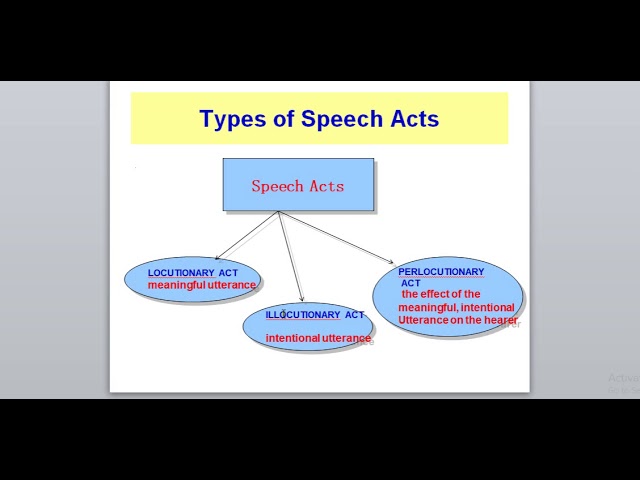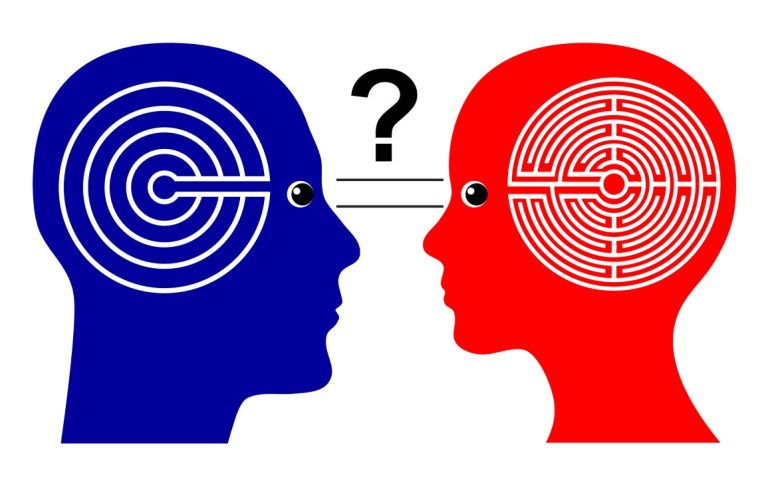What are the Types of Speech Acts?
Speech acts can be categorized into three types: locutionary acts, illocutionary acts, and perlocutionary acts. In a locutionary act, words are used to make a statement or convey meaning.
Illocutionary acts involve the intention behind the speech, such as making a request or giving an order. Perlocutionary acts focus on the effect the speech has on the listener, like convincing or persuading them. Speech acts have different types, namely locutionary acts, illocutionary acts, and perlocutionary acts.
As the name suggests, locutionary acts involve the use of words to communicate meaning or make a statement. In contrast, illocutionary acts are centered around the intentions behind the speech, such as making a request or giving an order. Lastly, perlocutionary acts focus on the impact the speech has on the listener, such as influencing or persuading them in some way. Understanding these different types of speech acts is crucial for effective communication and interaction.

Credit: www.semanticscholar.org
Assertive Speech Acts
When it comes to communication, we often use speech acts to convey our intentions and meanings. One such type of speech act is the assertive speech act. In this section, we will explore the definition, examples, and characteristics of assertive speech acts.
Definition And Examples
An assertive speech act, also known as a constative speech act, is used to state or convey factual information or beliefs. It aims to present an accurate representation of reality through statements that are true or false. Assertive speech acts can take various forms, including making statements, reporting facts, providing explanations, or expressing opinions.
Here are a few examples to illustrate assertive speech acts:
- Statement: “The sun rises in the east.”
- Fact Report: “According to the latest research, global warming is increasing.”
- Explanation: “Rainbows occur when sunlight is refracted and reflected by water droplets in the air.”
- Opinion: “In my opinion, smartphones have revolutionized the way we communicate.”
Characteristics
Assertive speech acts possess distinctive characteristics that set them apart from other types of speech acts:
- Truth-oriented: Assertive speech acts aim to convey information that is either true or false, reflecting objective reality.
- Factual in nature: These speech acts are centered around presenting facts, data, evidence, or personal beliefs.
- Verifiability: In most cases, assertive speech acts can be verified or proven through evidence, logical reasoning, scientific methods, or personal experiences.
- Intentional and deliberate: Speakers consciously intend to state or assert something, often with the goal of informing, persuading, or expressing their viewpoint.
- Subject to revision: Unlike certain speech acts, such as directives or commissives, assertive speech acts are open to revision or change when new evidence or information emerges.
Understanding assertive speech acts and their characteristics is crucial for effective communication. It enables us to convey information accurately, express our beliefs and opinions, and engage in meaningful discussions.

Credit: www.youtube.com
Directive Speech Acts
Directive speech acts are a type of speech act in which the speaker intends to get the listener to do something or to influence the listener’s behavior in some way. These speech acts are typically characterized by imperatives, requests, or suggestions. In this section, we will explore the definition and examples of directive speech acts as well as their important characteristics.
Definition And Examples
A directive speech act is an utterance that is intended to prompt the listener to take a specific action. It involves making a request or giving an instruction to the listener. These speech acts are designed to elicit a response or to bring about a change in the listener’s behavior. They can be classified into various categories, including commands, requests, suggestions, and warnings.
Let’s take a look at some examples of directive speech acts:
- A mother telling her child, “Please clean your room.”
- A teacher instructing the students, “Open your textbooks to page 25.”
- A boss telling an employee, “Finish the report by the end of the day.”
- A friend suggesting, “Why don’t we go out for dinner tonight?”
- A sign warning, “Do not enter without permission.”
Characteristics
Directive speech acts possess a set of characteristics that distinguish them from other types of speech acts. Understanding these characteristics can help us comprehend the intention behind a speaker’s utterance and the impact it may have on the listener. Some key characteristics of directive speech acts are:
- Imperative Forms: Directive speech acts often employ imperative verb forms, such as “clean,” “open,” “finish,” or “do not enter.” These forms convey a sense of command or instruction to the listener.
- Assertiveness: Directive speech acts are typically more assertive in nature than other types of speech acts. They are direct and straightforward, aiming to influence the listener’s behavior without room for ambiguity.
- Intentional: Directive speech acts are purposeful; the speaker intends to bring about a specific action from the listener. The intention behind the speech act is to influence the listener’s behavior or to achieve a desired outcome.
- Power Dynamics: Directive speech acts often involve a power dynamic between the speaker and the listener. For example, a boss giving instructions to an employee or a teacher instructing students. This power dynamic can shape the effectiveness of the directive speech act.
- Context-Dependent: The interpretation of directive speech acts heavily relies on the context in which they occur. The same utterance can have different implications depending on factors like the relationship between the speaker and listener, cultural norms, and the specific situation.
Understanding the characteristics of directive speech acts can help us analyze the underlying intentions and implications of a speaker’s request or instruction. It allows for a deeper understanding of the power dynamics and influence within a given interaction.
Commissive Speech Acts
In the realm of speech acts, commissives are a particularly interesting type. Commissive speech acts are rooted in the realm of promises, commitments, and pledges. When someone makes a commissive statement, they are expressing their intention to carry out a specific action or fulfill a certain obligation in the future. This category of speech acts can have a profound impact on interpersonal relationships and communication dynamics, as they involve making explicit commitments or promises.
Definition And Examples
A commissive speech act is a type of utterance where the speaker commits themselves to carrying out a future action or fulfilling a certain obligation. It is a declaration of intent or a promise made by the speaker. Here are a few examples to illustrate this type of speech act:
- “I promise I will help you move next weekend.”
- “I swear I will finish this project by the deadline.”
- “I commit to attending the meeting on Friday.”
Characteristics
Commissive speech acts have several distinct characteristics that set them apart from other types of speech acts:
- Future-oriented: Commissive statements refer to actions or obligations that will be fulfilled in the future.
- Intentional: The speaker consciously expresses their intention to carry out the promised action.
- Volitional: Commissives emphasize the speaker’s willingness and commitment to fulfill their promise.
- Binding: Once a commissive statement is made, it creates an expectation and obligation for the speaker to follow through with their commitment.
The power of commissive speech acts lies in their ability to establish trust and reliability within interpersonal relationships. When someone makes a promise or commitment, it creates a sense of accountability and enhances trust between individuals.

Credit: prezi.com
Expressive Speech Acts
Speech acts are expressive forms of communication that can be categorized into various types. These include assertive acts that make statements, directive acts that give commands, commissive acts that make commitments, expressive acts that convey emotions, and declarative acts that change the state of affairs.
Definition And Examples
Expressive speech acts refer to verbal expressions that communicate the speaker’s feelings, emotions, or personal attitudes towards a particular subject or situation. These speech acts express the speaker’s thoughts and emotions rather than conveying information or making requests. They are often used to express opinions, beliefs, gratitude, apologies, congratulations, condolences, or even to vent frustration or anger. Examples of expressive speech acts include statements like “I’m so excited!” to express enthusiasm, “I’m sorry for your loss” to express condolences, or “Thank you so much!” to express gratitude.Characteristics
Expressive speech acts have certain characteristics that distinguish them from other types of speech acts. Understanding these characteristics can help in recognizing and interpreting these expressions correctly: 1. Subjectivity: Expressive speech acts are highly subjective and reflect the speaker’s personal emotions, attitudes, and opinions. They provide insight into the speaker’s thoughts and feelings. 2. Emotional intensity: Expressive speech acts often involve strong emotions. They can indicate joy, anger, sadness, surprise, happiness, or any other emotion felt by the speaker. 3. Non-propositional content: Unlike other speech acts that convey propositional meanings or information, expressive speech acts focus more on expressing feelings rather than conveying facts or making statements. 4. Appraisal function: Expressive speech acts are often used to evaluate or appraise a situation or event from the speaker’s perspective. They can express approval, disapproval, admiration, or dissatisfaction. 5. Tone and non-verbal cues: Non-verbal cues such as tone of voice, facial expressions, gestures, and body language play a significant role in expressive speech acts. These cues help in interpreting the speaker’s emotions and attitudes accurately. It is important to note that expressive speech acts can vary across cultures and individuals. The same expression may carry different meanings or emotions to different people. Therefore, understanding the context and considering cultural nuances is crucial for effective communication. In summary, expressive speech acts allow individuals to express their emotions, attitudes, and personal opinions. They involve subjective statements that convey the speaker’s feelings rather than providing objective information. Recognizing the characteristics of expressive speech acts can help in interpreting these expressions accurately and fostering better communication.Frequently Asked Questions Of What Are The Types Of Speech Acts?
What Are The 5 Basic Types Of Speech Acts?
The 5 basic types of speech acts are: assertives (making assertions or stating facts), directives (giving commands or making requests), commissives (making promises or commitments), expressives (expressing feelings or attitudes), and declaratives (declaring something and causing a change in the world).
What Are The 4 Different Speech Acts?
The 4 different speech acts are assertives, directives, commissives, and expressives. Assertives state facts or provide information. Directives give instructions or requests. Commissives commit to future actions. Expressives convey emotions or feelings.
What Are The 3 Types Of Speech Act And Their Functions?
The three types of speech acts are locutionary, illocutionary, and perlocutionary. Locutionary acts refer to the literal meaning of words. Illocutionary acts express intentions, such as making requests or giving orders. Perlocutionary acts aim to influence the thoughts or actions of others.
What Are The 7 Functions Of Speech Act?
The 7 functions of speech act include stating, commanding, questioning, promising, expressing gratitude, apologizing, and complimenting. These functions help individuals communicate their intentions and convey specific messages in various social interactions.
What Are The Different Types Of Speech Acts?
Speech acts are classified into five main categories: assertive, directive, commissive, expressives, and declaratives. Each type serves a different purpose in communication.
Conclusion
To summarize, understanding the different types of speech acts is crucial for effective communication. By recognizing the distinctions between assertive, directive, commissive, expressive, and declarative speech acts, individuals can better navigate social interactions and convey their intentions clearly. Whether in personal or professional settings, mastering these speech acts can enhance relationships, facilitate agreements, and ensure mutual understanding.
By continually honing these skills, we can become more successful communicators in our daily lives.



